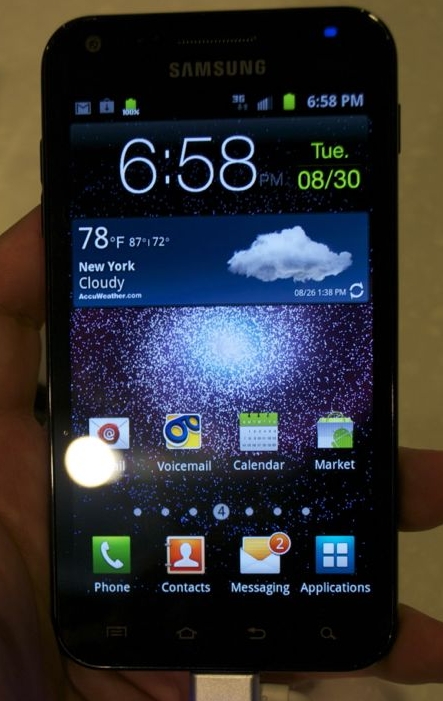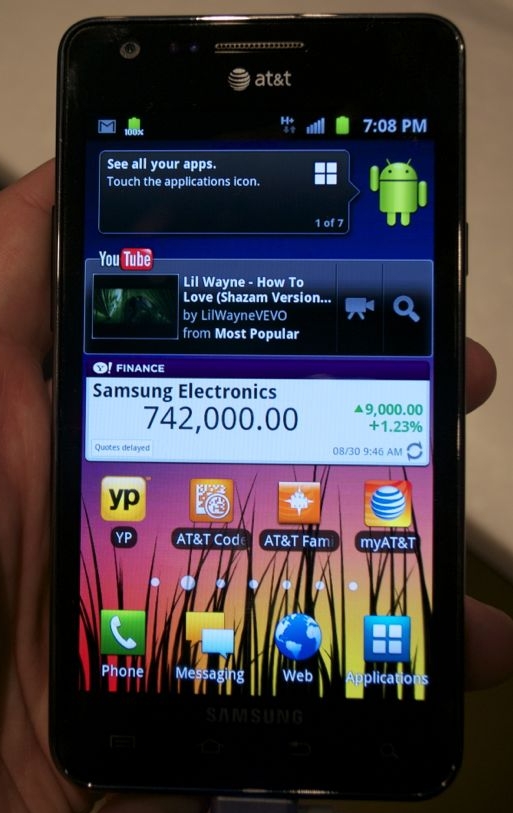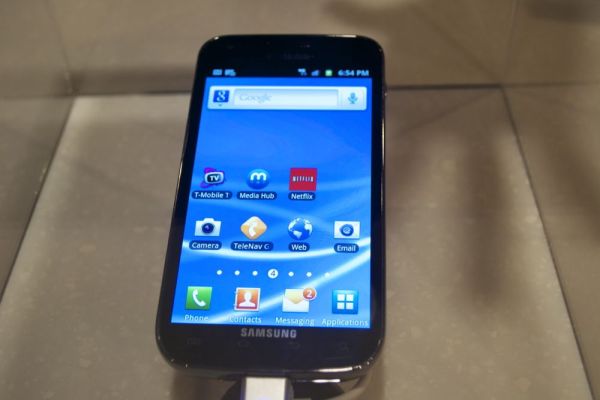Hands on with the US-bound Samsung Galaxy S IIs
by Jason Inofuentes on August 31, 2011 1:37 AM EST- Posted in
- Laptops
- Samsung
- Android 2.3
- Galaxy S II
- Mali 400
- TouchWiz
- Exnos
Samsung has already sold 5 million of them in 85 days in Korea and Europe, but until now the Galaxy S II has been just a dream in a US phone buyers eye. All that was rectified tonight when Samsung announced three Galaxy S II variants that will be entering the US market on Sprint, AT&T and T-Mobile. Brian already ran through the specifications but we thought we'd provide some hands-on impressions from our time with them and a little overview. TouchWiz 4.0 was also showed off, and the skin is comprehensive enough that we'll devote some time in the future to flesh it out. First, a gallery from the event. Apologies for some of the shots, but lining up the best shot in this evironment is impossible.
Sprint Epic 4G Touch

Sprint will be first out of the gates with the Epic 4G Touch, launching on September 16th for $199 on contract. The device is one of two 4.5" slates whose WVGA (800x480) Super AMOLED Plus display is bright and vivid, and surprisingly crisp given the relatively low resolution. There's no denying that pixel density enthusiasts would have been thrilled at 720p or even qHD, but in the hand the only real effect was to make the icons comically large. Horizontal size not withstanding these devices are light and thin, though Sprint's variant is not the thinnest clocking in nearly a millimeter thicker than AT&T's at 9.65 mm. On first grab the lightness gave the impression I was holding a mock-up and not the real thing, but this WiMAX equipped featherweight was smooth and fast in navigating the device's UI. Nenamark was loaded on the device so we ran it through its paces and though the benchmark is not one we regularly feature the device smoothly ran it at 46+FPS. For those thinking of joining The Now Network, this phone will be hard to pass up.
AT&T Samsung Galaxy S II

Ma Bell has foregone alternate naming for their variant, and as the pictures bear out, this is also the closest to the international version that has made the rounds through out Asia and Europe. The 4.3" device lends itself better to the WVGA resolution, and feels noticeably smaller in the hand. Absent in all of these devices is the physical home button so prominent in the international version, but each feels solid in the hand despite a glossy plastic exterior that doesn't feel as premium as the soft touch or metal frames found on recent HTC phones. AT&T's SGSII shares the Exynos SoC and Mali GPU of the Epic 4G Touch and international version so while it is smaller it is no less fast. An NFC radio is on hand, though it was not mentioned at the event it's confirmed by FCC documentation. Release and pricing have not been announced, but we imagine they won't stray far from Sprint's date and pricing. Though it wasn't listed in the specifications released tonight, the phone is rated for HSPA+ at 21.1 Mbps, matching the international version and most likely indicating that both are using the same X-Gold 626 baseband. So, with AT&T's model so closely aping the already shipping internation version, why not be the first out the door? Not sure, but we hope it means it's not long coming.
T-Mobile
T-Mobile is joining Sprint in the 4.5" form factor, though the demo models they had on hand presented rounder corners than Sprint's variant. And that's pretty much all we can say. Samsung and T-Mobile representatives committed to a dual-core processor but would go no further with launch date, pricing or specifications. Indeed, the demo models were kept under glass and not even the representatives were allowed to handle them, except to turn them on periodically so we could appreciate the display. As Brian pointed out in the earlier piece, this could end up being Qualcomm powered, in particular given that a dual core Snapdragon paired with Qualcomm's MDM8220 could make this T-Mo's first DC-HSPA+ 42 Mbps device.
Overview
Since its announcement back at Mobile World Congress in February, the Samsung Galaxy S II has generated a lot of excitement and that excitement has lead to impressive sales figures. This, of course, follows in the success of their first generation Galaxy S devices. But what is it about these phone's that is lighting the world on fire? In a big way, this has to do with Exynos, Samsung's succesor to Hummingbird. The two components of Exynos are a dual-core Cortex A9 clocked at 1.2 GHz and the Mali-400 GPU, both ARM designs. ARM states that clock-for-clock a single-core Cortex-A9 should outperform a Cortex-A8 by about 20%. Give that same A9 a 20% clock bump, and a 40% performance improvement is possible before the second core even comes into the picture. But that only tells us why the Galaxy S II is such a huge improvement over, say, the Nexus S.
What makes the Galaxy S II seem to drastically outpace newer devices like the Droid 3, whose 1 GHz OMAP 4 SoC also features an A9 processor? The special sauce, as Brian will delve into further in his upcoming review of the international Galaxy S II, is Samsung's ability to leverage the Mali-400 to accelerate UI elements and even elements of the browsing experience, as well.
September 16th is fast approaching, so we'll know soon just how well the US variants will perform relative to their international siblings. In the meanwhile, stay tuned for our review and some more Samsung news at the IFA Unpacked event on Thursday.

















36 Comments
View All Comments
mlj11 - Wednesday, August 31, 2011 - link
I figure Anandtech.com's the best place to ask this...One criticism always leveled against SAMOLED screens is how displayed colors appear to be over-saturated, ie not true to life.
This time round, Sammy's added an option (at least in the international version of this phone) under: Settings>Display>Background effect that allows users to choose from 3 pre-set color saturation levels.
Guys, when you go through your rounds of testing on these phones and if the option is available, could you include a segment on the color levels using the preset values? I would really like to know if color reproduction is better on the lower-saturated one.
Thanks in advance!
lpjz290 - Wednesday, August 31, 2011 - link
I think that's a great suggestion. Sometimes the AMOLED screen do show oversaturations with colors. If it's true that Samsung have included the saturation control, it should be reviewed and tested.medi01 - Wednesday, August 31, 2011 - link
Ever compared "raw" image to jpeg generated by Canon/Nikon cameras?jpeg is ALWAYS more saturated.
Why? Because PEOPLE LIKE IT THAT WAY.
mlj11 - Wednesday, August 31, 2011 - link
And your point is..?I'm interested in this from a phone hardware perspective, and how the different technologies that go into making different displays affect what a user sees.
Specifically, I'd like to know whether the option to change the display's saturation levels brings the accuracy of color reproduction of the SAMOLED+ closer to LCD levels.
You can lose the snarky comments, thanks.
duffman55 - Wednesday, August 31, 2011 - link
Some people like really saturated colors. Of course there are varying degrees of saturation, and the SAMOLED display is very saturated. The colors on that display are too unnatural. It's still a great display, though. Just not as good as it should be for displaying real life objects.I haven't spent much time using the new SAMOLED+ display or the Nexus S display with the revised color temperature (not sure if they changed the color saturation).
Does anyone know why Samsung calibrates their displays like this? I think it would be great if they included the tool for changing the color saturation to the user's liking.
ImSpartacus - Wednesday, August 31, 2011 - link
They do it because it's a consumer product and consumers like it that way.It's the same glossy-matte argument all over again.
Eventually, it will get absurd and manufacturers will provide options to deal saturation back into reality.
s44 - Wednesday, August 31, 2011 - link
From the tweets, Brian may actually end up testing supercurio's fine-grained calibration app.B3an - Wednesday, August 31, 2011 - link
My GSII has this colour option (non-US version luckily, as the US versions are a mess. 3 variants of the same phone with different names, looks and hardware?! ridiculous)By default the colour is actually pretty accurate. I have a 30" professional LCD monitor that i've calibrated with hardware and software, it's extremely accurate with colours and for a phone the GSII isn't far off in comparison. BUT... my friend also has GSII and on his the colours ARE saturated on default setting. So it has to be turned down in the colour setting, which makes saturation a little too low. The contrast is also way too high on his phone and this cant be adjusted. It isn't as bring on the same setting either. I also tested another GSII in a store and this was closer to mine but still different.
Basically it seems that each screen can vary quite a lot, more than is normal.
Maybe it will be different for the US versions, infact i'm sure it will be being as they dont even all have the same screen on each!
agentsmithitaly - Wednesday, August 31, 2011 - link
It will interesting to see battery life tests. One thing I've noticed in previous smartphone reviews is that you didn't tested standby battery life.My girlfriend Galaxy S II, europe version, has difficulty to reach 15 hours standby with a very light use, ie. a couple 5-min calls and nothing else.
I've set the brightness to minimum, switched off wi-fi, gps and bluetooth, removed animated background, set baseband to GSM only, updated to latest KE7 firmware but the situation improved only by 1-2 hours, which why probably I'll buy one of that portable power banks for emergencies.
I hope it's only a firmware issue and that sometimes Samsung manages to iron it out.
Dual core CPUs seems to use lots of power, they should give a little more weight and thickness (it's just 116 grams and 8.5 millimeters!) for a 2000 mAh battery, 1650 isn't enough.
warisz00r - Wednesday, August 31, 2011 - link
This news should interest you thenhttp://blog.gsmarena.com/samsung-releases-a-2000-m...